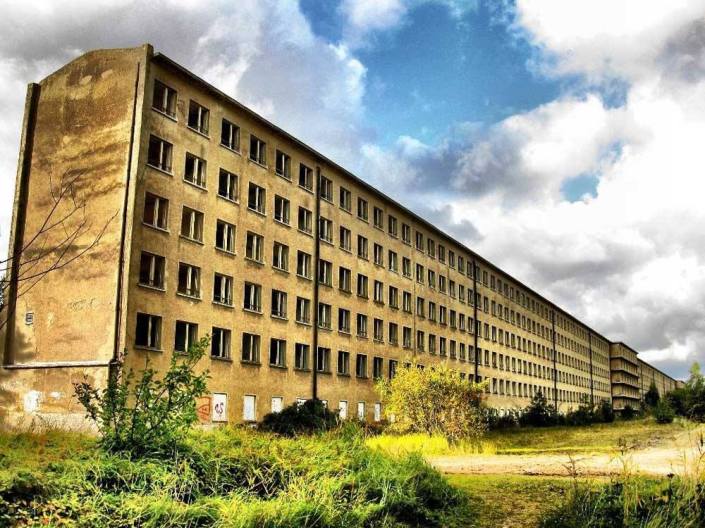
Normally the Files would not be focusing on abandoned relicts in Germany, for it is not in the domain. There are enough websites that focus on this topic, regardless of where. This includes Abandoned Iowa, which I’m subscribed to and focuses on abandoned buildings and bridges. Not surprising as I grew up in Iowa and have a love for historic bridges.
Yet this entry takes us to the island of Rügen in the German state of Mecklenburg-Pommerania (in German: Mecklenburg-Vorpommern) in northeastern Germany, and this building here. As I was doing research on information for the next Germany quiz on this rather sparsely populated state with lots of flora and fauna, one of the readers brought this item to my attention.
The island itself has a very beautiful setting, with steep chalk cliffs overlooking the Baltic Sea, acres of forest and wildlife habitat, and kilometers of beaches extending (30) kilometers. From Rostock, the state’s largest city, it is approximately 55) km. Yet the island has one eyesore, which is located at Prora. While McPomm (which is the abbreviated form of the state’s name) once belonged to East Germany and the communist state was famous for its construction of block apartments in every city and town with more than 3,000 inhabitants during its existence, the Prora building dates back to the age of the Third Reich, according to local sources.
Located north of Binz, the Prora Building itself is five kilometers long and has five stories. Its architecture resembles that of the Third Reich and may have been the works of architect Albert Speer, who was in charge of most of the architecture in Germany during the regime of Adolf Hitler. Born in Mannheim in 1905, Speer’s rise to fame came when he was anointed by Hitler to be his architect in 1933. There he was in charge of the construction of modern buildings and redesigning districts in German cities whose aesthetic features were geometric with only design patterns and the symbol of National Socialism as the only decoration. Much of his architecture still exists in Germany today, despite attempts by locals in states like Bavaria (where Hitler began his rise to power in the 1920s), to eradicate the buildings because of their associations with the Third Reich. Speer later became in charge of the artillery division but towards the end of the war, confronted Hitler because of his irrational decision-making in response to Germany losing the war.
Because his role was almost solely an architect and he had very little to do with Hitler’s genocidal machine designed to kill “non-Aryans,” Speer was sentenced to 20 years in prison, in comparison to most of his Nazi colleagues receiving the death penalty. After his release from prison in Spandau, Speer maintained his residence for most of his life in Heidelberg, writing three still controversial novels about his life in the Third Reich and donating most of his royalties to Jewish charities. Shortly before his release in 1966, his son Albert Jr. established an architectural firm in Frankfurt (Main), whose geometrical modern architecture follows a similar pattern of his father’s, minus the decorative features.
And with that, we go back to Prora and the building complex, which has been sitting empty and intact but in a desolate state. Records show that Speer had been involved in a decree to relocate the Jews from their quarters to different areas, and this building may have been the place for placing them there. Yet by the same token, it would also have been a place to house the troops, especially as Germany had a strong Navy at that time. Record will not be able to show that for when World War II commenced in 1939, construction on the building stopped and remained in its original form all the way up to the present. We will never know whether Speer had anything to do with it, who was in charge of building this complex nor what it was used for.
Or will we?
Any ideas regarding the logic behind building this complex that is now considered an eyesore to many people, please place your thoughts and info in the comment section. If you wish to share photos of it, go ahead and do so. Sometimes a visit to the complex helps spurn a few ideas behind the history of this building, let alone a few ideas of what to do with the complex.
Many thanks to Doc Harding for the photos that are posted. Rügen is a highly recommended place to visit.



I’ve been here and they are now renovating many into luxury flats. It’s a bit eerie, but quite impressive in size.
LikeLike
Seriously?
“And with that, we go back to Prora and the building complex, which has been sitting empty and intact but in a desolate state. Records show that Speer had been involved in a decree to relocate the Jews from their quarters to different areas, and this building may have been the place for placing them there. Yet by the same token, it would also have been a place to house the troops, especially as Germany had a strong Navy at that time. Record will not be able to show that for when World War II commenced in 1939, construction on the building stopped and remained in its original form all the way up to the present. We will never know whether Speer had anything to do with it, who was in charge of building this complex nor what it was used for.”
“KdF, Prora”: Google it?
Please?
Nevermind, heres a link: https://de.wikipedia.org/wiki/Prora
LikeLike